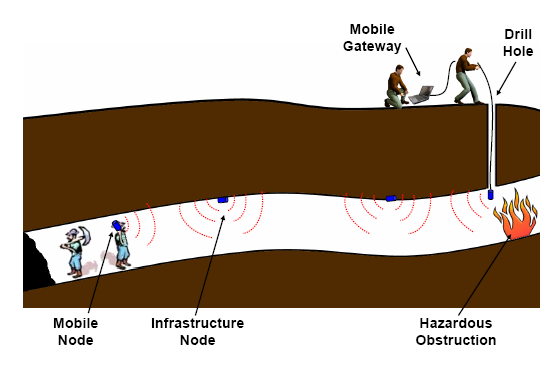Coal Mine Monitoring
Over the past decade, there has been a surge of accidents
in coal mines across the world. In most cases, miners are trapped several
thousand feet below the surface for several hours while rescuers try to find
their location and attempt to communicate with them. In January 2006, 13 miners
were trapped for nearly two days in the Sago Coal Mine in West Virginia, USA. The miners were less than a few hundred feet from an
escape route but were not aware of it. Similarly, in February 2006, in the
Pasta de Conchos coal mine in Mexico, 65 miners were trapped more than 1 mile below the ground
level. After more than 100 hours of rescue attempts, the authorities were still
unable to locate or establish communication with the miners. In both cases, the
prevalent wired communication systems were destroyed when a portion of the mine
collapsed and there was no way to re-establish connection to the affected
areas. Fatalities often result in such mining incidents.
The normal practice to check the status of the trapped
miners is to drill a narrow hole (of 1-2 inch radius) from the surface to a
mine tunnel and drop a microphone, camera and air quality sensors at different
locations around the disaster area. This method provides limited access to the
affected region as medium-sized mines may span several miles across. Another method
of communicating to the miners is by installing a loop antenna that is several
miles long, over the surface of the mine. This scheme uses a low-frequency
transmitter on the surface to send one-way broadcasts of short text messages and
is unable to get feedback about the status or location from the miners below.
Our group was invited to investigate the use of wireless sensor
nodes to track miners and to evaluate their viability as an end-to-end rescue
communication network for miners during an incident. We proposed the
establishment of a self healing wireless network in such mine-like environments
to maintain communication in the remaining connected network. If a wireless
node was lowered through the drill-hole, it could re-establish communications with the remaining network and
initiate two-way communication with the miners. In addition, the miners would
be able to leave broadcast voice mail-type messages and allow it to propagate to
all nodes in the remaining network. It is important to note that during normal
operation, the network’s primary task is to track miners and record
environmental data.
|
|

Figure 1: Example Coal Mine Scenario
|
|
|
|
|
|
|
|
|
|